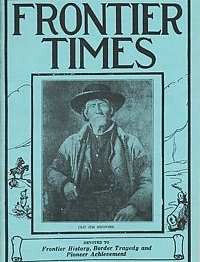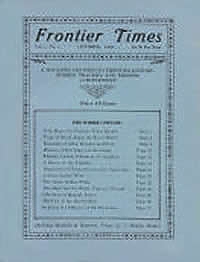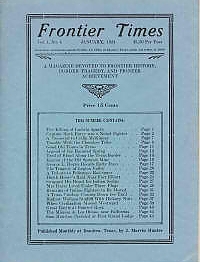By using our website, you agree to the use of cookies as described in our Cookie Policy
Magazines & Instant Downloads
Vol 08 No. 11 - August 1931
On the Cover – Col. Jim BridgerOld Jim Bridger Excellent account of one of the real heroes of the Old West, James Bridger, born in 1804 and died in 1881. A granite monument to this great frontier character bears the following inscription "James Bridger, 1804-1881. Celebrated as a Hunter, Trapper, Fur Trader and Guide. Discovered Great Salt Lake 1824, the South Pass 1827. Visited Yellowstone Lake and Geysers 1830. Founded Ft. Bridger 1843. Opened Overland Route by Bridger's Pass to Great Salt Lake. Was Guide for U. S. Exploring Expeditions, Albert Sidney Johnston's Army in 1847, and G. M. Dodge in U. P. Surveys and Indian Campaigns 1856-66. This Monument is Erected as la Tribute to His Pioneer Work by Maj. Gen. G. M. Dodge. Further Mentions: Colonel Henry Inman * James Ashley * Kit Carson * old John Smith, another noted frontiersman * General Gatlin * Fort Gibson * Sir George Gore, whose strange tastes led him in 1885 to abandon life in Europe and bury himself for over two years among the savages in the wildest and most unfrequented glens of the Rocky Mountains * Gordon Cumming * Mr. Fullstuff * the adventures of Baron Nunchauuen * Henry Morgan's One RomanceBy Charles B. Driscoll. Henry Morgan was one of the most ruthless of pirates, his daring, brutality, and intelligence made him the most feared, and respected buccaneer of all time. Henry Morgan really was the king of all pirates. But he had a soft spot. This is the story of his ill-famed and disappointing experience with romance while raiding Panama in the 1670s. Further Mentions: Lieut. George Williams * Senora Teresa Aguilar, bride of an important merchant * FIFTY YEARS AGO Account of the origins and establishment of the town of Abilene, the famous Kansas Cow-town. Old Viesca Marjorie Rogers, Marlin, Texas. The colonizing of Falls county, of which Marlin is the county seat, began in 1834, when Empresario Robertson decided to locate the capital of his colony on the west bluffs of the Brazos, about five miles from the present town of Marlin. The lands here were rich, and the range good and wood and water were plentiful. The river at this point was very low, and at times was not over knee-deep to the horses of the prospectors. The famous falls of the Brazos, known then as one of the landmarks of the new country, were about ten perpendicular feet, and the water below the falls abounded in fish. This country around the falls was all that the travelers could desire. It was a well known landmark due to the fact that the river could be easily forded here and travelers enroute to various sections of the state usually crossed the river at the falls and camped. But Robertson made a fatal mistake when he chose the west bluffs of the river for his capital city, as so many of his colonists chose lands on the east side of the river and had to cross back and forth to work. This gave the Indians advantage of them. Their homes could be sacked and families killed while they were away tilling the fertile soil. Had he selected the east side of the river for his seat Viesca might have been a large city today. Many counties east and west of the Brazos were embraced in this contract for settlement. Milam, Bell, Williamson, Burnett, Lam.pasas, Bosque, Coryell, Hamilton, Erath, Hood, Comanche, Brown and Eastland made up the territory known as the municipality of Viesca. It has been estimated that this colony embraced a territory equal to one-sixth of the entire province of Texas. Milam was the first county to be organized after the revolution of 1836. At the first Congress of the Republic Viesca was renamed Milam county for Benjamin R. Milam, who entered the ranks of the volunteers as a private soldier and was foremost in the assault on Goliad, and also rallied 300 volunteers by the famous cry, "Who will go with old Ben Milam into San Antonio?" This famous old Milam Land District was divided into many smaller counties in the early '50s. Robertson appointed J. G. H. Pierson, well known surveyor, agent to divide the land and lay out the town of Sarahville D' Viesca. This is the history of that town. Further Mentions: William H. Steele * Mr. Pierson * Sam T. Allen, Albert G. Perry, J. G. W. Pierson, Alexander Thompson and J. W. Parker * Parker's Fort * Captain Joseph Daniels, Indian fighter * Major Erath, Captain Bryant and Captain John Bird, Z. N. Morrell, pioneer Baptist preacher and Colonel Jack Hays * Cowan * a drunken pioneer gave it the name of Bucksnort * The Morgans, Mehiefees, Smiths, Seviers, Bartons, Jones, Langs, Billingsleys, Killebrews, Perrys and others converted the savage country into Falls county * Captain E. B. Smith * Isaac Parker and J. Davis * Waco * Blue Ridge community * Dr. Allensworth Adams lived just north of the present courthouse square, and the community was dubbed Adams * Churchill Jones * the Runaway Scrape * Edward Hanrick * A. H. Morrell * Judge Robert E. Baylor * Bartlett and Green ran a general merchandise here * the H: & T. C. railroad * Sterling C. Robertson * TEXAS LONGHORNS PRESERVED The Texas Longhorn cattle, which once roamed the plains in countless numbers, will not perish from the earth, notwithstanding their marked inferiority to members of the bovine tribe which have taken their places. The Longhorns would doubtless soon have become extinct but for the … Passing Of "World" Recalls Feat Of "Nellie Bly"Edward S. Van Zile. Account of female reporter, Nellie Bly. Further Mentions: Joseph Pulitzer * Eugene Field's "Sharps and Flats" * Managing Editor John A. Cockerill * Charles Edward Russell * Joseph Howard, . Jr., Julian Hawthorne, "Bill" Nye, Henry Guy Carleton, David Graham Phillips, Nym Crinkle, Arthur Brisbane * Miss Cochran-Nellie Bly's real name * Amos Wright * Walker Blaine * Grover Whalen * Astor House * JUAREZ AIDED EL PASO TO GET COUNTY SITE Though a jubilee year for El Paso, 1881 spelled loss of prestige for San Elizario and Ysleta. With the railroads meeting at El Paso, a new Athens was rising that would never be satisfied until it became the seat of county government. Ysleta had taken the county seat from San Elizario in 1878; now it was Ysleta's turn to fade from the picture. The astute Ysletans, seeing the mounting population of El Paso, knew their town would soon be outstripped… Cabeza De Vaca; Pioneer Par ExcellenceBy Colonel C. C. Smith, U. S. Army Retired. Quite a lenthy and detailed account of the adventurer/explorer’s journeys including the lifestyles of the natives and the topography and descriptions of the regions he covered. The story of Alvar Nunez Cabeza de Vaca was the first white man to explore the Southwest, which he did accompanied by three companions, Alonso del Castillo, Andrea Dorantes and a Moorish negro called Estevanico. When de Vaca and his companions were washed ashore on the coast of Texas there began for them a series of adventures and episodes as thrilling as any that have ever befallen human beings. First they were slaves of the Indians, then seers, and finally came to be regarded as gods. They passed through the hands of many tribes, but no doubt their first captors were the Karankawas or the Tonkawas of East Texas, their final guiding friends the Tarahumares of Mexico. Further Mentions: the King of Castile * Alhaja, a goat-hereder * Las Navas de Tolosa * Alhaja * Fanny Bandelier * Panfilo de Narvaez * Pedro de Alvarado and Cristobal de Olid * an old Spanish fort called La Popa * Sagua La Grande * Major E. N. L. Glass * Rio del Fuerte * Private Derwin * Private Gordon * John R. Bartlett * Mustang Pond * Wild China Ponds * Capt. J. G. Bouske * Espejo * Valle de San Bartolo in Chihuahua * Andres Dorantes, son of Pablo Dorantes * Gibraleon * Alvar Nunez, or Cabeza de Vaca, Andres Dorantes, Alonzo del Castillo Maldonado * Juan Nunez, Dorames, Cabeza de Baca, (Cabeza de Vaca), Castillo, Maldonado * Nuestra Senora de Guadalupe in Zacatecas * Aldonza Maldonado * Castillo and Maldonado * Mr. H. W. Daly * Corazones * the bay of Espiritu Santo * the S. P. R. R * Captain Cooney's FateBy James H. Lycons. Brothers, James and Michael Cooney were of Irish parentage, Canadian born, and each of them were redheaded. Just a few years before the Civil War started in the United States they were in the early years of manhood and made up their minds to leave their Canadian home and emigrate to the United States. They located in Chicago, Illinois. When President Lincoln issued a call for volunteers, James Cooney enlisted in the Eighth Regiment United States Cavalry and eventually became Quartermaster Sergeant of that regiment. At the end of the Civil War the Eighth Regiment was transferred to Fort Bayard, New Mexico where he was in many lively scraps with the Apaches. After his term of enlistment expired in 1876 he went back to the Mogollon Mountains, accompanied by several other men, and the prospecting of the mineral belt was begun. James Cooney and Harry McAllister discovered and located the Fanny Mine, which has produced many thousands of dollars worth of gold and silver. In the year of 1878 the Mogollon Mining district was organized according to United States law and regulations. James Cooney, G. C. Williams, W. J. Burns, Frank Vingo, George Doyle, Alex McLaughlin and John Lambert were the leaders in the move to organize. At that time the Mogollon Mountains were in Socorro county. Two camps, or towns, were started, one was named Alma and the other Mogollon, they were about eight miles apart. Both camps had built Stockades for defense purposes against the Apaches. Early in the year of 1880 the Apaches had a big war party out under the command of their big chief, Victorio and during the latter days of April they had put up a fight to wipe out of existence the town of Alma. After James’ death, his brother, Captain Michael Cooney, came from New Orleans to take over his mine. Unfortunately, the other Cooney died somewhat fatefully as well, while searching for a lost gold mine in the Mogollon mountains. The canyon where his body was found has been named Cooney Canyon. The lost mine has never been rediscovered, if it ever even existed. Here is the sad account. Further Mentions: the Mogollon mountains * General O'Neil * his find on Sycamore Creek * Charles Powell * the T. J. Cattle Company * John Stout and John Foster, two well-known prospectors and experienced mountain men * the Abb Alexander cattle ranch * R. L. Lewis * Eli Clark, Ray Bell and Frank Beach. * But The Fellers Call Him "Bill" By Myrtle Gebhart. Account of the life of "The Cowboy Philosopher" Will Rogers. Further Mentions: Samuel Pepys * Dave Butler * Clem Rogers, father of William Penn Adair Rogers * Claremore, Okla * Bill Hart were guests at Hoot Gibson's ranch * Fred Stone * Charles Dillingham * Willow Hassel School at Neosho, Mo *A rancher named Zach Mulhall * Betty Blake Alabama Indians First Finders Of Oil In Texas Dabney White. Dabney White. History of East TX lumber industry, railroading, the region around piney woods, "Big Thicket", oil discoveries, and oil springs at Spindletop, Sour Lake and Nacogdoches. Further Mentions: Wyatt Hanks; Woodville; Judge Samuel P. Wilson; Judge M. Priest; Judge Hobby, father of Ex-Gov. Will Hobby; Judge L. B. Hightower; Bronson Cooper and John Henry Kirby; the T. & N. O. Railroad from Beaumont to Rockland; Col. Jo Rice; old town of Woodville; the old Kirby home-stead; Dr. T. Ward White; Mrs. Chambers; Geologists Hitchcock, Lucas or Dr. Robert T. Hill; Cone Johnson; The Flat Rock FightJ. J. Starkey. In 1876, one year after the last Indian raid in Kerr county, a fight occurred with American horse thieves at Flat Rock, near the head of the Pedenales in Gillespie county, according to Sam Glenn, Sr., of Kerrville. Glenn and Alex Crawford were out on the range on Second Creek, two miles northeast of Kerrville near the Fredericksburg road, one day in 1876 when they observed five men approach two horses, belonging to John Henson, Deputy Sheriff, who lived in Kerrville. The horses' hobbles were removed and a bell taken off and the horses led away. Glen and Crawford hurried to town and notified Capt. Chas. Schreiner, who was captain of the Minute Men (an organization of volunteer frontiersmen who responded to such calls as this. Twelve or fifteen men were soon in the saddle and under the leadership of Captain Schreiner were in hot pursuit of the outlaws. Near the head of the Pedenales River, in Gillespie County, the horse thieves had camped at a place known as Flat Rock and turned the horses loose to graze. This was then, the scene of the fight. Further Mentions: A family by the name of Fannin who lived near Flat Rock * Leon Springs * Max Ane Store * Flat Rock * Bob Jarmon, Jones Glenn, Sam Glenn, Ralph Bacon, Jim Pruitt, Hiram Davis, Jim Holloman and F. J. Hamer * Sam Glenn and Jim Holloman
$4.95
‹ Back








